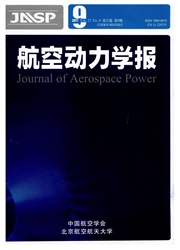

 中文摘要:
中文摘要:
航空发动机中的齿轮常因振动而发生疲劳失效,分析其振动成因是必要且急需的.基于能量法,对薄直齿轮的自激振动进行了研究,提出了一种可用于预测薄直齿轮发生横向自激振动的理论方法,推导了自激力和阻尼力对齿轮振动做功的表达式,通过分析系统能量的变化,理论上确认了薄直齿轮发生自激振动的可能性,并给出了发生自激振动时的条件及载荷.通过数值模拟,分析了重合度、节径数和阻尼比对齿轮自激振动稳定性的影响.结果表明:从动齿轮后行波和主动齿轮前行波在阻尼不足时会发生自激振动而失稳,在相同条件下,低节径振型更容易发生自激振动.
 英文摘要:
英文摘要:
The fatigue failures caused by the vibration often happen in the gears of the aero-engines, so it is urgently necessary to analyze the cause of the vibration. The self-excit- ed vibration of the thin spur gear was studied based on the energy method and a theoretical method used to predict the self-excited vibration was proposed. The expressions of the exci- tation work and damping work to the travelling wave vibration of the gear were derived. By analyzing the change of the system energy, the likelihood of the occurrence of the self-excited vibration for the thin spur gear was verified in theory, while the condition and gear load in occurrence of the self-excited vibration were also determined. Through the numerical simula- tion, the influences of the contact ratio, nodal diameter and damping ratio on the stability of the self-excited vibration were studied. Results show that the self-excited vibration will oc- cur in the backward travelling wave of the driven gear and the forward travelling wave of the driving gear in the underdamped situation. For the same conditions, the self-excited vibra- tion is more easily to occur in low nodal diameters vibration mode.
 同期刊论文项目
同期刊论文项目
 同项目期刊论文
同项目期刊论文
 期刊信息
期刊信息
